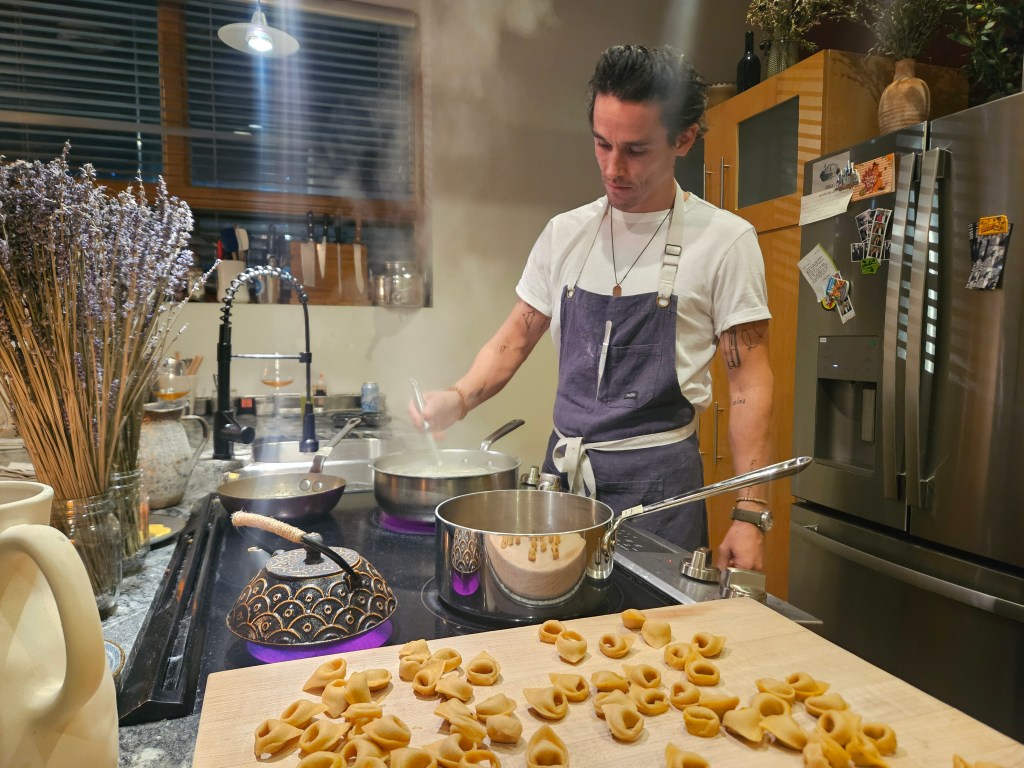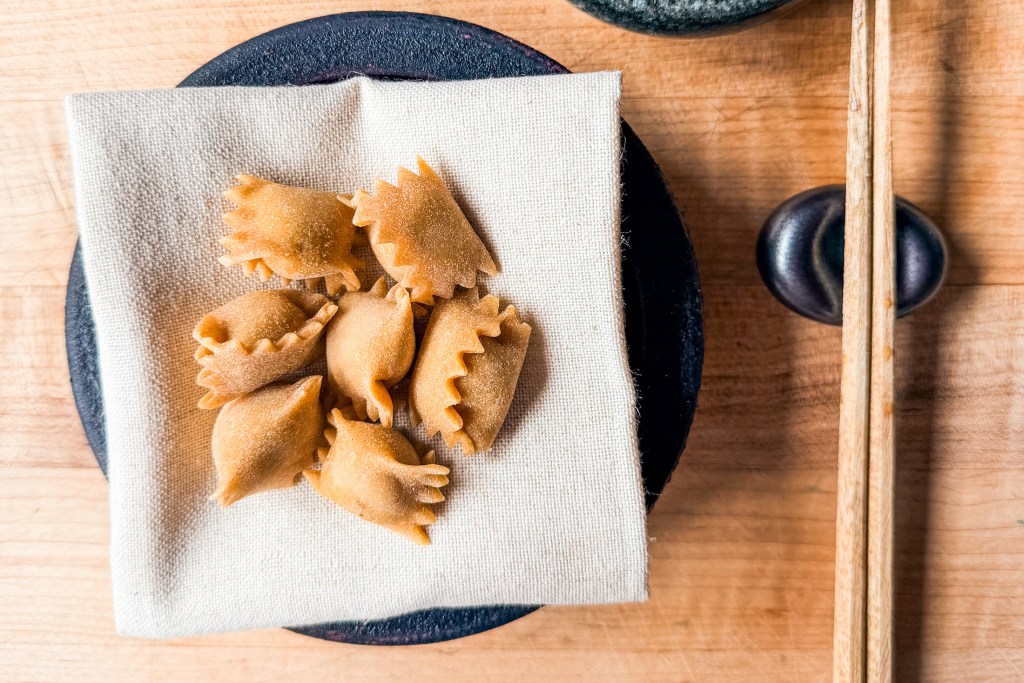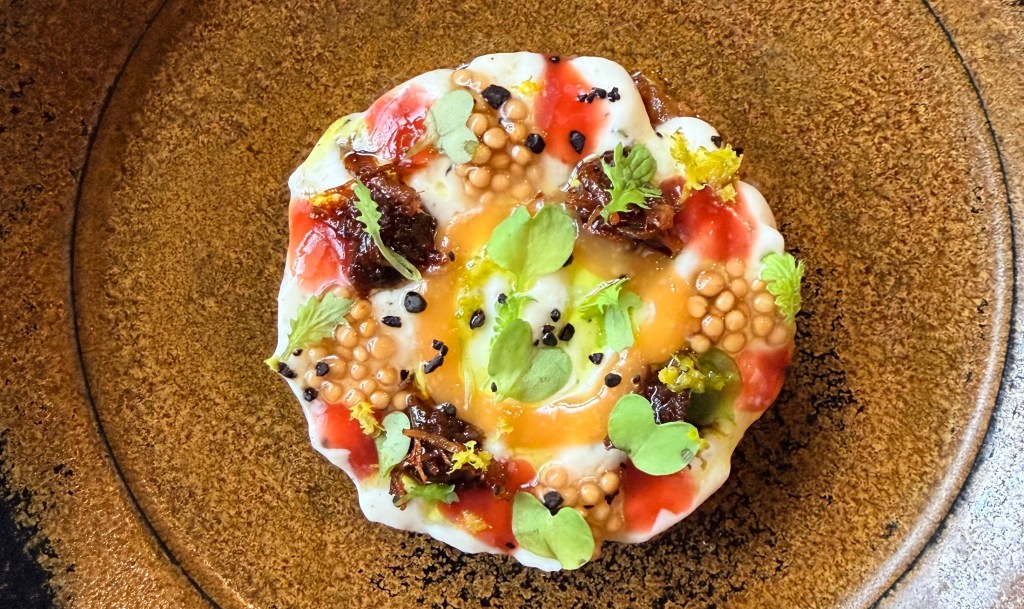
Courtesy of Domī

Audio By Carbonatix
They say you shouldn’t take your work home with you. But when your work is your passion, perhaps you don’t have much of a choice. At least that’s the case for chef Matthew Drazick Halip, who has launched what he’s calling an “at-home dinner series” out of his RiNo townhouse. Domī (Latin for “at home”) is focused on the source of his personal and professional obsession: pasta.
In fact, he defines the five-course tasting menu as a “pasta omakase,” where each type of pasta served is mixed, rolled and shaped entirely by hand using traditional wooden kitchen tools and techniques.
He’s not the first chef to host pop-up dinners in his home. Brian De Souza and Syd Younggreen launched the Guest in their Boulder house before expanding to the Regular. One difference with Domī, however, is that Halip is already working a full-time job — at Colorado’s only two-Michelin-starred restaurant, The Wolf’s Tailor.
“It started as just a passion project,” he says. “I was posting a lot of [pasta photos] on Instagram, and people were asking when they could come try the food. I was like, ‘I can throw a dinner party,’ and just did it.”
This year, make your gift count –
Invest in local news that matters.
Our work is funded by readers like you who make voluntary gifts because they value our work and want to see it continue. Make a contribution today to help us reach our $50,000 goal!

Antony Bruno
Hand-Rolled, Story Told
Plenty of Denver-area restaurants are making fresh pasta these days, but none are doing so entirely by hand the way that Halip does at Domī. This pasta is as old-school as it gets. Halip pours flour onto a wooden board and uses his hands to create a bowl in which to pour the eggs, which he then mixes together with only a fork. He presses the shaggy egg-wet dough into a ball and kneads it against a board, putting his entire body into the effort.
“She will tell you what she wants, and she’ll spit out what she doesn’t want,” he says, referring to the ball of dough he made. “You just have to listen to her.”
And then there’s the real differentiator: rolling it all out into a thin sheet shaped as a perfect circle (called a sfoglia) using nothing but a three-foot-long wooden rolling pin (called a mattarello) in a ritual common in the trattorie of Bologna but rarely seen in the U.S.
“I tend to do things the hard way,” Halip shrugs. “I like the slow, meticulous process of making pasta like this.”
It’s a technique he learned in Italy, where, after his initial education at the La Scuola Internazionale di Cucina Italiana outside of Parma, he worked in several Michelin-starred restaurants before diving deeper into the world of handmade pasta at the Vecchia Scuola Bolognese in Bologna.

Antony Bruno
He then worked for the chef credited for popularizing hand-rolled pasta in the U.S. (and fellow VSB graduate), Evan Funke, at his eponymous LA restaurant. After moving to Denver last year, Halip did a stint at Restaurant Olivia before landing at Wolf’s Tailor, where he’s been ever since.
While pasta aficionados say rolling pasta by hand results in a better texture, thanks to the wood-on-wood friction it involves, few diners will likely notice the difference immediately. But Halip still insists on doing it the traditional way because he both enjoys doing it and he likes the story it tells about what Domī is trying to accomplish.
“Pasta isn’t just food, it’s language, and this is my version of telling a story that I’m very interested in,” he says. “You wouldn’t be here if I was sheeting this pasta with a machine. That’s not unique. There’s no story there. But this is a unique story that no one has really seen until recently.”

Courtesy of domī
Traditional Methods, Global Influences
While the pasta making might be traditional, the resulting dishes are not. Each course is a wildly creative exploration of how far the pasta format can be stretched (no pun intended), incorporating flavor profiles and ingredients that draw inspiration from Asia, Scandinavia, and even Colorado, in addition to Italy.
“Pasta is a blank canvas that allows you to do whatever you want,” Halip says. “It’s something that you can manipulate in a lot of ways.”
For starters, he takes the highly unusual route of adding about 2 percent of shio koji (the byproduct of fermented rice) to his flour, which he makes at home, that lends a distinctive flavor to the resulting pasta.
Halip then fills his pastas with unexpected ingredients and surrounds them with sauces that are sure to raise any nonna’s eyebrow in shock. The choices made are all based on seasonality and sustainability, using every component of fresh ingredients across the entire menu.
That might include turning buckwheat sourdough discard into a thin, spaghetti-like chitarra, served cold in a soy dashi dressing with king trumpet mushrooms. Or forming pasta scraps into a sort of fregola, which is pan-fried and covered with creme fraiche, cured trout, cherry boshi, and peach ponzu, along with some wasabi greens and pickled mustard seeds. Another dish he calls a “tazza” is like a ravioli wheel stuffed with confit duck and roasted kabocha squash, in a broth spiked with XO sauce.
The result is a meal of both great complexity and delicate balance, prepared before you and served chef’s counter style, accompanied by a detailed explanation of both the inspiration behind each dish and the ingredients it contains.
But don’t come in expecting the same thing twice. One of the appeals of a chef-driven dinner party like Domī is that it’s nothing like a traditional restaurant’s mission of repetition and consistency. The chef is doing this to scratch a creative itch that diners get to experience. The only way that works is to come in with an open mind and a sense of adventure.
“I like to create a sense of mystery,” says Halip about keeping each menu a secret. “You kind of create a degree of expectation, and then just let the brain do what the brain’s gonna do.”

Courtesy of Domī
Invitation Only, Screening Required
Halip’s Domī dinner parties are currently limited to four guests, with reservations available by invite only. Interested diners can request an invite by submitting contact information, as well as a link to their Instagram profile (which Halip uses as a sort of screening device before inviting strangers into his home). There’s also typically a quick phone call involved to confirm any reasonable dietary restrictions (“obviously I can’t do gluten-free,” he notes) and set expectations.
As for cost, it’s technically a dinner party, but it carries a suggested minimum donation of $100. Halip’s hosted a handful of dinners already, and is booked out through the end of the year, with about 150 names still on the invite request list.
Like other chef-hosted dinner parties, Domī is already poised to expand out of the house. Halip is in discussions with different venues to potentially hold larger events in the new year. But he’s cagey about whether he’ll ever seek to open a restaurant of his own.
“I don’t know what it is yet,” he says. “Time will tell. Right now, it’s just getting in front of people and having a conversation, and kind of seeing where it goes from there.”
To request an invite or learn more, visit domīden.com or follow it @domīdenver on Instagram.